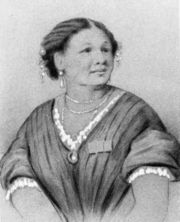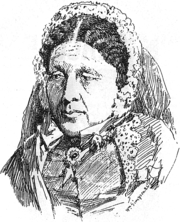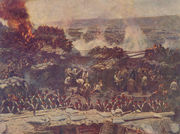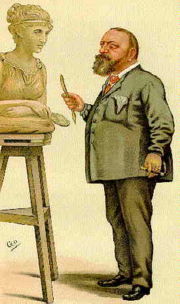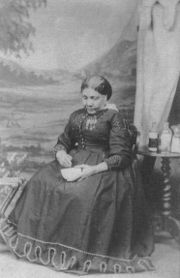Mary Seacole
2007 Schools Wikipedia Selection. Related subjects: British History 1750-1900
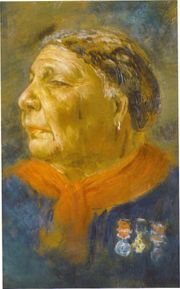
Mary Jane Seacole ( 1805 – 14 May 1881) was a mixed-race British nurse. Born in Jamaica, she operated boarding houses in Panama and Crimea while simultaneously treating the sick. Seacole was taught herbal remedies and folk medicine by her mother. Always of a nomadic disposition, on hearing of the terrible conditions of the Crimean War and certain that her knowledge of tropical medicine would be of use, she travelled to London and volunteered as a nurse. Although an expert at dealing with cholera, her application to join Florence Nightingale's team was rejected.
She then borrowed money to make the 4,000 mile journey alone. On arrival she distinguished herself, treating the wounded on the battlefield. On many occasions treating wounded soldiers from both sides while under fire whereas Florence Nightingale and her nurses were based in a hospital in Turkey. Following the cessation of hostilities in 1856 she found herself stranded and almost destitute, and was saved from penury by the Commander-in-Chief of the British Forces Lord Rokeby who organized a benefit.
Seacole was lauded in her lifetime, alongside Florence Nightingale, but after her death was forgotten for almost 100 years. Today she is noted not only for her bravery and medical skills but as "a woman who succeeded despite the racial prejudice of influential sections of Victorian society"
Her autobiography, Wonderful Adventures of Mrs. Seacole in Many Lands (1857), a vivid account of her life and experiences, is one of the earliest autobiographies by a black woman.
Early life, 1805–26
Seacole was born in Kingston, Jamaica as Mary Grant, the daughter of a white Scottish officer in the British Army and a free Jamaican Creole woman. Seacole's mother was a "doctress", a healer who used traditional Caribbean and African herbal remedies. She ran Blundell Hall, a boarding house at 7 East Street in Kingston, at the lower end of the road closer to the harbour, and, at the time, one of the best hotels in Kingston. Many of the residents were invalid Europeans, particularly soldiers and sailors, often suffering from the endemic yellow fever caught soon after their arrival in the tropics. Here Seacole acquired her nursing skills. She records early experiments, imitating her mother by ministering to a doll, progressing to domestic pets, before finally helping her mother to treat human beings.
Seacole was proud of her Scottish ancestry, calling herself a "Creole", a term which at the time was used most commonly either in a racially neutral sense or to refer to the offspring of white settlers. Legally, she would have been classified as a " mulatto", a person of mixed race with limited political rights. Robinson speculates that she may technically have been a " quadroon". Seacole emphasises several times her personal vigour, distancing herself from the contemporary stereotype of the "lazy Creole". However, she also proclaims to be "proud of [her] relationship" with black American slaves demonstrated by the "few shades deeper brown upon [her] skin".
The West Indies were an extremely lucrative outpost of the British Empire in the late eighteenth century. In 1789, one fifth of Britain's foreign trade was with the British West Indies, increasing to a third in the 1790s. Britain's economic interests were protected by a massive military presence, with some 69 line infantry regiments serving there from 1793 to 1801, and another 24 from 1803 to 1815.
Seacole spent some years in the household of an elderly woman, whom Seacole calls her "kind patroness", before returning to her mother. She appears to have been treated a member of her patroness's family, receiving a good education. As the educated daughter of a Scottish officer and a free black woman with a respectable business, Seacole would have been accorded a relatively high position in Jamaican society.
Circa 1821 Seacole visited London staying for a year she visited relations - the merchant Henriques family). Although London had a significant population of black people, she records that a companion, a West Indian with skin darker than her own "dusky" shades, was taunted by children in the street. Seacole herself was "only a little brown", which was nearly white, according to Ramdin. Undaunted, she returned to London approximately a year later, on this occasion bringing a "large stock of West Indian pickles and preserves for sale". From this time on, her later travels would be as an "unprotected" woman, without chaperone or sponsor, an unusual disposition for the era. Seacole returned to Jamaica in 1825
In the Caribbean, 1826-1851
After returning to Jamaica Seacole nursed her "old indulgent patroness" through an illness. Finally returning to the family home at Blundell Hall after the death of her patroness a few years later. Seacole then worked alongside her mother. Occasionally being called to assist at the British Army hospital at Up-Park Camp. During this period she traveled in the Caribbean, visiting the English colony of New Providence in the Bahamas, and the Spanish colony of Cuba, and new republic of Haiti. Seacole records these travels, but omits mention of significant current events, such as the Christmas Rebellion in Jamaica of 1831, and the partial abolition of slavery in 1834 or the full abolition of slavery in 1838.
Seacole married Edwin Horatio Hamilton Seacole in Kingston on 10 November 1836. Her marriage from betrothment to widowhood is described in just nine lines at the conclusion of the first chapter of her autobiography. Unusually, in a time when mixed-race relationships were common but mixed-race marriages were rare, he was a white man, baptised in Prittlewell in Essex in 1803, the sixth son of Thomas Seacole and his first wife, Ann. His middle names are intriguing: Robinson reports the legend in the Seacole family that Edwin was an illegitimate son of Horatio Nelson and Emma Hamilton, adopted by Thomas, a local "surgeon, apothecary and man midwife". Seacole's will indicates that Horatio Seacole was Nelson's godson: she left a diamond ring to her friend, Lord Rokeby, "given to my late husband by his Godfather Viscount Nelson", although Robinson notes no mention of this godson was made in Nelson's will or its codicils. Edwin was a merchant, but seems to have had a poor constitution. The newly married couple moved to Black River and opened a provisions store, which failed to prosper. They returned to Blundell Hall in the early 1840s.
During 1843 and 1844 Seacole suffered series of personal disasters. She and her family lost much property in a fire in Kingston on 29 August 1843. Blundell Hall burned down, and was replaced by New Blundell Hall, "better than before". Then her husband died in October 1844, followed by her mother. After a period of desperate grief, in which Seacole says she did not stir for days, she composed herself, "turned a bold front to fortune", and assumed the management of her mother's hotel. She put her rapid recovery down to her hot Creole blood, blunting the "sharp edge of [her] grief" sooner than Europeans who "nurse their woe secretly in their hearts". She absorbed herself in work, declining many offers of marriage. Seacole became widely known and respected, particularly amongst the European military visitors to Jamaica who often stayed at Blundell Hall. She treated patients in the cholera epidemic of 1850, which killed some 32,000 Jamaicans. Seacole attributed the outbreak to infection brought on a steamer from New Orleans, demonstrating knowledge of contagion theory. This first-hand experience benefited her in the following five years.
In Central America, 1851–1854
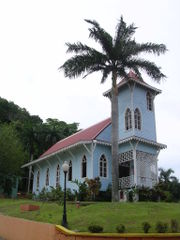
In 1850, Seacole's half-brother Edward moved to Cruces, Panama, then part of New Granada. There, approximately 45 miles (70 km) up the Chagres River from the coast, he followed the family trade by establishing the "Independent Hotel" to accommodate the many travelers between the east coast and west coasts of the United States. The number of travelers had increased due to the 1849 California Gold Rush. Cruces was the limit of navigability of the Chagres River during the rainy season, from June to December. Travelers would ride donkeys approximately 20 miles along the Las Cruces trail from Panama City on the Pacific coast to Cruces, and then 45 miles downriver to the Atlantic at Chagres (or vice versa). In the dry season, the river subsided, and travelers would switch from land to the river a few miles further downstream, at Gorgona. Most of these settlements have now been submerged by Gatun Lake, formed as part of the Panama Canal.
In 1851, Seacole traveled to Cruces to visit her brother, shortly after her arrival, Cruces was struck by cholera, a disease which had reached Panama in 1849. Seacole was on hand to treat the first victim, who survived, establishing Seacole's reputation and bringing her a succession of patients as the infection spread. While the rich paid she treated the poor for free. However many, both rich and poor, succumbed. She eschewed opium, preferring mustard rubs and poultices, purgative calomel ( mercuric chloride), sugars of lead ( lead(II) acetate), and rehydration with water boiled with cinnamon. While her preparations had moderate success, she faced little competition - the only other treatments coming from a "timid little dentist", an inexperienced doctor who was sent by the Panama government, and the Catholic church, which paraded images of saints and prayed for divine intervention.
The epidemic raged through the population, Seacole later expressed exasperation at their feeble resistance, claiming they "bowed down before the plague in slavish despair". She performed an autopsy on an orphan child for whom she had cared, giving her "decidedly useful" new knowledge to put to good use. Towards the end of the epidemic, Seacole herself succumbed but survived. Cholera was to return again: Ulysses S. Grant passed through Cruces in July 1852 on military duty. 120 men, a third of his party, died of the disease there or shortly afterwards en route to Panama City.
Despite the problems of disease and climate Panama remained the favoured route between the coasts of the United States. Seeing a business opportunity, Seacole opened a "British Hotel", although this was more of a restaurant than an hotel, she seems to have had a problem with her clientèle as it is recorded she struggled to keep the rowdy travelers under control.
As the wet season ended in early 1852, Seacole joined other traders in Cruces in packing up to move to Gorgona. She records an American giving a speech at a leaving dinner in which he wished "God bless the best yaller woman he ever made" and asked the listeners to join with him in rejoicing that "she's so many shades removed from being entirely black”. He went on to say that "if we could bleach her by any means we would ... and thus make her acceptable in any company as she deserves to be." Seacole was incensed: in her reply, she said that she would have been just as happy to have a complexion "as dark as any nigger's", and wished for "the general reformation of American manners". Salih notes the use of a white American pidgin vernacular, contrasting with Seacole's clear English, as an inversion of renditions of "black" speech in contemporary literature, and as a claim of moral and intellectual superiority. Seacole also comments on the positions of responsibility taken on by escaped American slaves in Panama, in the priesthood, the army and public offices, commenting that "it is wonderful to see how freedom and equality elevate men". She also records an antipathy between the Panamanians and Americans, which she attributes in part to so many of the former once being slaves of the latter.
In Gorgona Seacole established a women-only hotel and continued to treat the sick. In late 1852 she traveled home to Jamaica, the journey was delayed and difficult as she encountered racial prejudice when trying to book on to an American ship forcing her to wait for a later British boat Soon after arriving home, Seacole was asked by the Jamaican medical authorities to minister to victims of a severe outbreak of yellow fever in 1853. She went on to organise a nursing service for the hospital at Up-Park Camp, about a mile from Kingston, composed of fellow Afro-Caribbean "doctresses" who seemed to be largely immune to the disease.
Seacole returned to Panama in early 1854 to finalise her business affairs, and three months later moved to the New Granada Mining Gold Company establishment at Fort Bowen Mine some 70 miles away near Escribanos to provide medical support. The superintendent, Thomas Day, was a relative of her late husband. Seacole had read newspaper reports of the outbreak of war against Russia before she left Jamaica, and news of the escalating Crimean War reached Seacole in Panama where she determined to travel to England to volunteer as a nurse, to experience the "pomp, pride and circumstance of glorious war" as she described it in Chapter I of her autobiography.
Crimean War, 1854-1856
The Crimean War lasted from 1854 until 1 April 1856 and was fought between Imperial Russia on one side and an alliance of the United Kingdom, France, the Kingdom of Sardinia, and the Ottoman Empire on the other. The majority of the conflict took place on the Crimean peninsula in the Black Sea and Turkey.
Thousands of troops from all the countries concerned were drafted to the area, disease broke out almost immediately, hundreds died of fever (mostly cholera), and hundreds more would die waiting to be shipped out, or on the voyage; and their prospects were little better when they arrived at the poorly-staffed, unsanitary and overcrowded hospital. In Britain a trenchant letter in The Times on 14 October triggered Sidney Herbert, Secretary of State for War, to approach Florence Nightingale to form a detachment of nurses to be sent to the hospital to save lives. Interviews were quickly held, suitable candidates selected, and Nightingale left for Turkey on 21 October.
Seacole quickly traveled from Navy Bay to England, bringing letters of recommendation from doctors in Jamaica and Panama.. On arrival she approached the War Office, asking to be sent to Crimea as an army nurse, but failed to secure an interview. She was told to see the Quartermaster General, and then the Medical Department, but was rebuffed at each turn. Seacole was rightly concerned that the racial prejudices she had experienced at the hands of Americans could be taking root in Britain.. She began to realise that she would not be employed even if there were a vacancy. Records survive which indicate other black women suffered the same fate However, many other candidates too found they were unable to meet Nightingale's exacting standards, considered too drunk, too old, or lacking in the social graces. Undaunted, Seacole applied to the Crimean Fund, a fund raised by public subscription to support the wounded in Crimea, for sponsorship to travel to Crimea, but again she was met with refusal.
Seacole finally resolved to travel to Crimea using her own resources, in order to open a "British Hotel". Business cards were printed and sent on to announce her imminent arrival and intention to open "a mess-table and comfortable quarters for sick and convalescent officers". Shortly afterwards, her Caribbean acquaintance, Thomas Day, arrived unexpectedly in London, and the two formed a partnership. They assembled a stock of supplies, and Seacole embarked on the Dutch screw-steamer Hollander on 27 January 1855 on its maiden voyage, to Constantinople. The ship called at Malta where Seacole encountered a doctor who had recently left Scutari, he wrote her a letter of introduction to Nightingale. On arriving in the Pera, the port of Constantinople, she took a caicque across the Bosphorus to visit Nightingales's hospital in Scutari where she encountered amongst the patients many familiar faces from the West Indies. At her meeting with Nightingale once again her offer of help was refused . After transferring most of her stores to the transport ship Albatross, with the remainder following on the Nonpareil, she set out on the four-day voyage to the British bridgehead into Crimea at Balaclava.
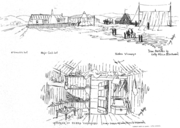
Returning to Balaclava, lacking proper building materials, Seacole gathered abandoned metal and wood in her spare moments, with a view to using the debris to build her hotel. She found a site for the hotel at a place she christened Spring Hill, near Kadikoi, some 3½ miles along the main British supply road from Balaclava to the British camp near Sevastopol, and within a mile of the British headquarters.
Hiring local labour the hotel was built from the salvaged driftwood, packing cases, and iron sheets, and salvaged architectural items — glass-doors and window-frames — from the village of Kamara. The new "British Hotel" opened in March 1855. An early visitor was Alexis Soyer, a noted French chef who had traveled to Crimea to help improve the diet of British soldiers. He recorded their meeting and describes Seacole as "an old dame of a jovial appearance, but a few shades darker than the white lily". The hotel was completed in July at a total cost of £800. It included a building made of iron, containing a main room with counters and shelves and storage above, an attached kitchen, two wooden sleeping huts, outhouses, and an enclosed stable yard. The building was stocked with provisions shipped from London and Constantinople, and local purchases from the British camp near Kadikoi and the French camp at nearby Kamiesch. Seacole sold anything "from a needle to an anchor" to army officers and visiting sight-seers. Meals were served at the Hotel, cooked by a black cook, the kitchen also provided outside catering. Many of Seacole's customers purchased goods on credit, causing problems later. Despite constant thefts, particularly of livestock, Seacole's establishment prospered. Opening five days a week and closing Sundays she settled into a routine of opening early, serving morning coffee to passing travelers, and then dealing with callers’ medical complaints, before traveling out herself to visit casualties..
Florence Nightingale took against Seacole, although she did little to express her disapproval overtly. The British Hotel charged for its services, supplied alcohol, and was open to visiting tourists as well as soldiers, leading Nightingale to later accuse Seacole of running an establishment that was little better than a brothel. Some years later corresponding to her brother-in-law Sir Harry Verney in 1870 she wrote that Seacole "kept - I will not call it a 'bad house' - but something not very unlike it - in the Crimean War... She was very kind to the men &, what is more, to the Officers - & did some good - & made many drunk". Worse, a second letter went further, stating that Seacole was a "woman of bad character" who kept "a bad house" (meaning a brothel). Robinson considers this charge unfounded and based on Nightingale's belief in her social superiority. Indeed, Nightingale sent nurses to assist at the Land Transport Hospital, close by Seacole's Hotel's nursing establishment, and further letters record her efforts to avoid association between her nurses and Seacole However, a letter from John Hall, Inspector General of Hospitals, dated 30 June 1856, records his gratitude for Seacole's assistance at the hospital.
Seacole often went out to the troops as a sutler, selling her wares near the British camp at Kadikoi, and attending to casualties brought out from the trenches around Sevastopol or from the Tchernaya valley. She was widely known to the British Army as "Mother Seacole".
Seacole often visited Cathcart's Hill, some 3½ miles north of the British hotel and overlooking the valley of the Tchernaya to the east and the trenches leading up to Sevastopol a further 2 miles to the north, a vantage point to view the hostilities, on one occasion attending wounded troops under fire she dislocated her right thumb, an injury which never healed entirely., she often treated French, Sardinian and Russian casualties alike. In a dispatch written on 14 September 1855, William Howard Russell, special correspondent of The Times wrote that she was a
-
- " a warm and successful physician, who doctors and cures all manner of men with extraordinary success. She is always in attendance near the battle-field to aid the wounded and has earned many a poor fellow's blessing." Russell also wrote that she "redeemed the name of sutler", and another that she was "both a Miss Nightingale and a Soyer". Seacole made a point of wearing brightly coloured, and highly conspicuous, clothing — often bright blue, or yellow, with ribbons in contrasting colours.
While Lady Alicia Blackwood later recalled that Seacole had
-
- "...personally spared no pains and no exertion to visit the field of woe, and minister with her own hands such things as could comfort or alleviate the suffering of those around her; freely giving to such as could not pay...".
In August Seacole was once again on Cathcart's Hill for the final assault on Sevastopol on Friday 7 September 1855. French troops led the storming, but the British were beaten back. By dawn on Sunday 9 September, the city was burning out of control, and it was clear that it had fallen: the Russians retreated to fortifications to the north of the harbour. Later in the day Seacole fulfilled a bet, and became the first woman to enter Sevastopol after it fell. Having obtained a pass she toured the broken town bearing refreshments and visiting the crowded hospital by the docks, containing thousands of dead and dying Russians. Her foreign appearance led to her being stopped by French looters, but she was rescued by a passing officer. She liberated some items from the city, including a church bell, an altar candle, and a 3-metre long painting of the Madonna.
After the fall of Sevastopol, hostilities continued in a desultory fashion The business of Seacole and Day prospered in the interim period, with the soldiers taking the opportunity to enjoy themselves in the quieter days. There were theatrical performances and horse racing events for which Seacole provided catering.
Seacole was joined by a young relative, a 14-year-old girl, Sarah, also known as Sally. Soyer described her as "the Egyptian beauty, Mrs Seacole's daughter Sarah", with blue eyes and dark hair. Nightingale alleged that Sarah was the illegitimate offspring of Seacole and Colonel Henry Bunbury. However, there is no evidence that Bunbury met Seacole, or even visited Jamaica, at a time when she would have been nursing her ailing husband. Ramdin speculates that Thomas Day could have been Sarah's father, pointing to the unlikely coincidences of their meeting in Panama and then in England, and their unusual business partnership in Crimea.
Peace talks began in Paris in early 1856, and friendly relations opened between the Allies and the Russians, with a lively trade across the River Tchernaya. The Treaty of Paris was signed on 30 March 1856, after which the soldiers left Crimea. Seacole was in a difficult financial position, her Hotel was full of unsaleable provisions, new goods arriving daily, and creditors demanding payment. She attempted to sell as much as possible before the soldiers left, but she was forced to auction many expensive goods for knock-down prices to the Russians who were returning to their homes. The evacuation of the Allied armies was formally completed at Balaclava on 9 July 1856, with Seacole "...conspicuous in the foreground...dressed in a plaid riding-habit...". Seacole was one of the last to leave Crimea, returning to England "poorer than [she] left it".
Back in London, 1856-1860
After the end of the war, Seacole returned to England destitute and in poor health. In the conclusion to her autobiography, she records that she "took the opportunity" to visit "yet other lands" on her return journey, although Robinson attributes this to her impecunious state requiring a roundabout trip. She arrived in August 1856, and considered setting up shop with Day in Aldershot, but nothing materialised. She attended a celebratory dinner for 2,000 soldiers at Royal Surrey Gardens in Kennington on 25 August 1856, at which Nightingale was chief guest of honour. Reports in The Times on 26 August and News of the World on 31 August indicate that Seacole was also fêted by the huge crowds, with two burly sergeants protecting her from the pressure of the crowd. However, creditors who had supplied her firm in Crimea were in pursuit. She closed the shop in Aldershot and moved to 1, Tavistock Street, Covent Garden and was made bankrupt. The Bankruptcy Court in Basinghall Street declared her bankrupt on 7 November 1856. Robinson speculates that Seacole's business problems may have been caused in part by her partner, Day, who dabbled in horse trading and may have set up as an unofficial bank, cashing IOUs.
At about this time, Seacole began to wear military medals. These are mentioned in an account of her appearance in the bankruptcy court in November 1856. A bust by George Kelly, based on an original by Count Gleichen from around 1871, depicts her wearing four medals, three of which have been identified as the British Crimean Medal, the French Legion of Honour and the Turkish Order of the Medjidie medal. Robinson says that one is "apparently" a Sardinian award ( Sardinia having joined Britain and France in supporting Turkey against Russia in the war). The Jamaican Daily Gleaner stated in her obituary on 9 June 1881 that she had also received a Russian medal, but it has not been identified. However, no formal notice of her award exists in the London Gazette, and it seems unlikely that Seacole was formally rewarded for her actions in Crimea: rather, she may have bought miniature or "dress" medals to display her support and affection for her "sons" in the Army.
Seacole's plight was highlighted in the British press,. As a consequence a fund was set up with many prominent people donated money, and on 30 January 1857, she and Day were granted certificates discharging them from bankruptcy. Day left for the Antipodes to see new opportunities, but Seacole's funds remained low. She moved from Tavistock Street to cheaper lodgings in 14 Soho Square in early 1857, triggering a plea for subscriptions from Punch on 2 May.
Further fund-raising kept Seacole to in the public eye. In May 1857 She wanted to travel to India, to minister to the wounded of the Indian Mutiny, but she was dissuaded by both the new Secretary of War, Lord Panmure, and her financial troubles. Fund-raising activities included the "Seacole Fund Grand Military Festival" which was held at the Royal Surrey Gardens, from Monday 27 July to Thursday 30 July 1857. This successful event was supported by many military men, including Major-General Lord Rokeby (who had commanded the 1st Division in Crimea) and Lord George Paget: over 1,000 artists performed, including eleven military bands and an orchestra conducted by Louis Jullien. The festival was attended by a crowd of 40,000 The one shilling entrance charge was quintupled for the first night, and halved for the Tuesday performance. However, production costs had been high and the Royal Surrey Gardens Company was itself having financial problems, and became insolvent immediately after the festival, as a result Seacole only received £57, one quarter of the profits from the event. When eventually the financial affairs of the ruined Company were resolved, in March 1858, the Indian Mutiny was over.
A 200-page autobiographical account of her travels was published in July 1857 by James Blackwood as Wonderful Adventures of Mrs. Seacole in Many Lands, the first autobiography written by a black woman in Britain Priced at 1s 6d a copy the cover bears a striking portrait of Seacole in red, yellow and black ink. Robinson speculates that she dictated the work to an editor, identified in the book only as W.J.S., who improved her grammar and orthography. In the work Seacole deals with the first 39 years of her life in one short chapter. She then expands six chapters on her few years in Panama, before using the following 12 chapters to detail her exploits in Crimea. She avoids mention of the names of her parents and precise date of birth. A short final "Conclusion" deals with her return to England, and lists supporters of her fund-raising effort, including Rokeby, again, Prince Edward of Saxe-Weimar, the Duke of Wellington, the Duke of Newcastle, William Russell, and other prominent men in the military. The book was dedicated to Major-General Lord Rokeby, commander of the First Division; and William Howard Russell wrote as a preface "I have witnessed her devotion and her courage… and I trust that England will never forget one who has nursed her sick, who sought out her wounded to aid and succour them and who performed the last offices for some of her illustrious dead".
Later life, 1860-1881
Seacole had joined the Roman Catholic church circa 1860, and returned to a Jamaica. politically changed in her absence. She became a prominent figure in the country. However, by 1867 she was again running short of money, and the Seacole fund was resurrected in London, with illustrious new patrons, including the Prince of Wales, the Duke of Edinburgh, the Duke of Cambridge, and many other senior military officers. The fund burgeoned, and Seacole was able to buy land on Duke Street in Kingston, near New Blundell Hall, where she built a bungalow as her new home plus a larger property to rent out.
By 1870, Seacole was back in London, and Robinson speculates that she was drawn back by the prospect of rendering medical assistance in the Franco-Prussian War. It seems likely that she approached Sir Harry Verney (the husband of Florence Nightingale's sister Persephone) Member of Parliament for Buckingham who was closely involved in the British National Society for the Relief of the Sick and Wounded, the fore-runner of the Red Cross. It was at this time Nightingale wrote her letter to Verney insinuating that Seacole had kept a "bad house" in Crimea, and was responsible for "much drunkenness and improper conduct".
In London, Seacole joined the periphery of the royal circle. Prince Count Gleichen, (a nephew of Queen Victoria, as young Lieutenant he had been one of her customers in Crimea) carved a marble bust of her in 1871 which was exhibited at the Royal Academy summer exhibition in 1872. Seacole also became personal masseuse to the Princess of Wales who suffered with white leg and rheumatism..
Seacole died in 1881 at her home in Paddington, London the cause of death on her death was given as " apoplexy". She left estate valued at over £2,500. After some specific legacies, many of exactly 19 guineas, the main beneficiary of her will was her sister, Louisa. Lord Rokeby, Colonel Hussey Fane Keane, and Count Gleichen (three trustees of her Fund) were each left £50; Count Gleichen also received a diamond ring, said to have been given to Seacole’s late husband by Lord Nelson. A short obituary was published in The Times on 21 May 1881. She was buried in St. Mary's Roman Catholic Cemetery, Harrow Road, Kensal Green, London.
Recognition
While well-known at the end of her life, Seacole rapidly faded from public memory. Her work in Crimea was overshadowed by Florence Nightingale's for many years. In recent years there has been a resurgence of interest in her and efforts to properly acknowledge her achievements. Seacole has become a symbol of racial attitudes and social injustices in Britain. Her story illustrates unceasing perseverance, courage and love in the face of prejudice. She was quoted as an example of "hidden" black history in Salman Rushdie's The Satanic Verses, like Olaudah Equiano: "See, here is Mary Seacole, who did as much in the Crimea as another magic-lamping lady, but, being dark, could scarce be seen for the flame of Florence's candle".
She has been better remembered in the Caribbean, where she was posthumously awarded the Order of Merit of Jamaica in 1991. The headquarters of the Jamaican General Trained Nurses' Association was christened "Mary Seacole House" in 1954, followed quickly by the naming of a hall of residence of the University of the West Indies at Mona. A ward at Kingston Public Hospital was also named in her memory. Her grave was rediscovered in 1973; a service of reconsecration was held on 20 November 1973, and her impressive gravestone was also restored by the British Commonwealth Nurses' War Memorial Fund and the Lignum Vitae Club. The centenary of her death was celebrated with a memorial service on 14 May 1981. An English Heritage blue plaque was erected by the Greater London Council at her residence in 157 George Street, Westminster, on 9 March 1985, but it was removed in 1998 before the site was redeveloped. A "green plaque" was unveiled at 147 George Street, in Westminster, on 11 October 2005. It has been proposed to re-position the blue plaque at another residence, in 14 Soho Square, where she lived in 1857.
By the 2000s, Seacole was a figure appearing in the National Curriculum, with her life story taught at primary schools in the UK alongside Florence Nightingale. A campaign to erect a statue of Seacole in London was launched on 24 November 2003, chaired by MP Clive Soley (now Lord Soley of Hammersmith). She was voted into first place in an online poll of 100 Great Black Britons in 2004.
An annual prize to recognise and develop leadership in nurses, midwives and health visitors in the NHS was named Seacole, and the Home Office commemorated her in early 2005 by naming part of its new headquarters at 2 Marsham Street in her honour New buildings at the University of Salford and University of Central England have also been named in her honour, and there is a Mary Seacole Centre for Nursing Practice at Thames Valley University and a Mary Seacole Research Centre at De Montfort University in Leicester.
An exhibition to celebrate the bi-centenary of her birth opened at the Florence Nightingale museum in London in March 2005. Originally scheduled to last for a few months, the exhibition was so popular that it was extended to March 2007.
The portrait identified as Seacole in 2005 was used for one of ten first-class stamps showing important Britons, to commemorate the 150th anniversary of the National Portrait Gallery.
